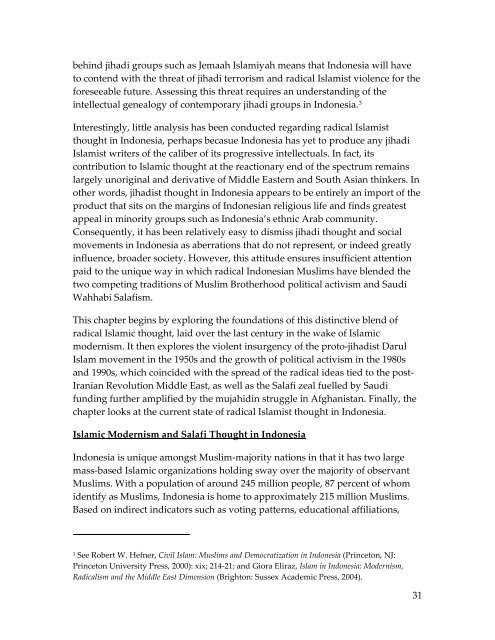You also want an ePaper? Increase the reach of your titles
YUMPU automatically turns print PDFs into web optimized ePapers that Google loves.
ehind jihadi groups such as Jemaah Islamiyah means that Indonesia will have<br />
to contend with the threat of jihadi terrorism and radical Islamist violence for the<br />
foreseeable future. Assessing this threat requires an understanding of the<br />
intellectual genealogy of contemporary jihadi groups in Indonesia. 3<br />
Interestingly, little analysis has been conducted regarding radical Islamist<br />
thought in Indonesia, perhaps becasue Indonesia has yet to produce any jihadi<br />
Islamist writers of the caliber of its progressive intellectuals. In fact, its<br />
contribution to Islamic thought at the reactionary end of the spectrum remains<br />
largely unoriginal and derivative of Middle Eastern and South Asian thinkers. In<br />
other words, jihadist thought in Indonesia appears to be entirely an import of the<br />
product that sits on the margins of Indonesian religious life and finds greatest<br />
appeal in minority groups such as Indonesia’s ethnic Arab community.<br />
Consequently, it has been relatively easy to dismiss jihadi thought and social<br />
movements in Indonesia as aberrations that do not represent, or indeed greatly<br />
influence, broader society. However, this attitude ensures insufficient attention<br />
paid to the unique way in which radical Indonesian Muslims have blended the<br />
two competing traditions of Muslim Brotherhood political activism and Saudi<br />
Wahhabi Salafism.<br />
This chapter begins by exploring the foundations of this distinctive blend of<br />
radical Islamic thought, laid over the last century in the wake of Islamic<br />
modernism. It then explores the violent insurgency of the proto-jihadist Darul<br />
Islam movement in the 1950s and the growth of political activism in the 1980s<br />
and 1990s, which coincided with the spread of the radical ideas tied to the post-<br />
Iranian Revolution Middle East, as well as the Salafi zeal fuelled by Saudi<br />
funding further amplified by the mujahidin struggle in Afghanistan. Finally, the<br />
chapter looks at the current state of radical Islamist thought in Indonesia.<br />
Islamic Modernism and Salafi Thought in Indonesia<br />
Indonesia is unique amongst Muslim-majority nations in that it has two large<br />
mass-based Islamic organizations holding sway over the majority of observant<br />
Muslims. With a population of around 245 million people, 87 percent of whom<br />
identify as Muslims, Indonesia is home to approximately 215 million Muslims.<br />
Based on indirect indicators such as voting patterns, educational affiliations,<br />
3<br />
See Robert W. Hefner, Civil Islam: Muslims and Democratization in Indonesia (Princeton, NJ:<br />
Princeton University Press, 2000): xix; 214-21; and Giora Eliraz, Islam in Indonesia: Modernism,<br />
Radicalism and the Middle East Dimension (Brighton: Sussex Academic Press, 2004).<br />
31


